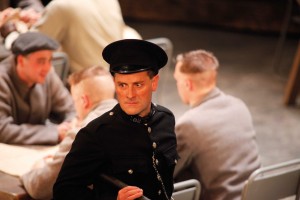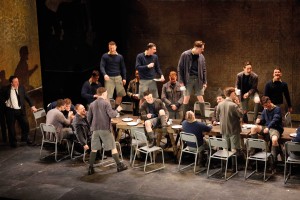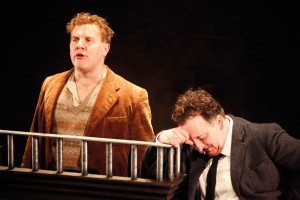Brendan Behan’s Borstal Boy
Published in Issue 6 (November/December 2014), Reviews, Volume 22Gaiety Theatre,
Verdant Productions,
11 Sept.–25 Oct. 2014
By Donal Fallon
In June 1959 the Irish Times noted that, with the success of The Hostage and his book Borstal Boy, the name of Brendan Behan ‘has become almost as well-known through theatrically-minded Europe as those of Shaw and Wilde’. Certainly, the Dubliner captivated crowds, both domestic and international, in the 1950s and early 1960s, and monuments to his memory, be they on the Chelsea Hotel in New York City or the Palace Bar in Dublin, recall a larger-than-life character and a deeply troubled soul. It is 50 years now since Behan’s passing in 1964, and his excessive drinking played no small role in putting him into the ground before his time. ‘As in his life, there was a crowd’, one journalist wrote of his well-attended funeral.
Undoubtedly, entertaining the crowd was paramount to Behan, be it upon a stage or in a public house. Behan the man and Behan the performer were often difficult to distinguish, but in Borstal Boy he provided readers with real and meaningful insight into his chaotic youth. His daughter, Blanaid, says in the programme notes that Borstal Boy remains her favourite work by the father she never knew, as before seeing it ‘my image of him was the public one, the larger-than-life character with whom I found it hard to identify’.
This is not the first time that Borstal Boy has taken to the stage of the Gaiety; Niall Toibín performed the role of Behan there in a staggering seven productions. In the run-up to the 1989 production, Toibín travelled to Mountjoy Prison and performed in character in a place that was all too familiar to Behan himself, who spent some time there for revolutionary activities in the early 1940s while still a young man. Of Behan, Governor Seán Kavanagh noted that ‘the better one grew to know him the more the impression grew that basically he was a very gentle person who in his senses would not hurt a fly’.

Ronan Leahy as one of the two truly nasty warders not afraid to use violence against the stubborn youngster.
This production opens, quite literally, with a bang. Utilising audio-visual backdrops with brilliant effect, the first thing the crowd sees is an animated ticking clock. Words from the republican song ‘My Old Alarm Clock’ are sung throughout the play by Behan, brilliantly performed here by both Peter Cooney and Gary Lydon, and the loud explosion forces the audience to sit up and pay attention. We learn that this explosion symbolises a bomb brought to England by Jerry Gildea, a young IRA volunteer from Dublin whose incendiary primer exploded in his pocket on a crowded British street.
‘When first I came to London, in the year of ’39,
The city looked so wonderful, and the girls were so divine.
But the coppers got suspicious, and they soon gave me the knock.
I was charged with being the owner of an old alarm clock.’
A young, nervous and stuttering Behan delivers the news of Gildea’s accident and arrest to his mother in Dublin in a scene that introduces us to the sixteen-year-old Behan, played here by Coonan, better known as the psychopathic Fran in the hugely popular TV drama Love/Hate. Here he plays a Behan who is nicely counterbalanced by the older and wiser successful writer, brought to life so well by Gary Lydon, who captures the brilliance and occasional buffoonery of the latter-day Behan perfectly. From Behan’s appearance down to every little mannerism, Lydon becomes Behan as the public will recall him. He plays the role of narrator throughout the production, often watching from the side of the stage as an invisible observer. The cast is staggering in scale, with 35 actors taking to the stage over the course of the production, but it is the two Behans who shine brightest.

Inmates having a laugh at mealtime—while the second half was hugely entertaining, it felt like the play became something of a light-hearted musical at times.
The play is divided mostly between two locations—Walton Prison in Liverpool and Hollesley Bay Borstal. There is an unevenness in terms of tone and content between the first and second halves of the production. The first half is rather dark at times, with the young Behan subjected to severe anti-Irish sentiment and physical abuse in Walton Prison, where Ronan Leahy and Charlie Hughes brilliantly perform the roles of two truly nasty warders not afraid to use violence against the stubborn youngster. While the second half was hugely entertaining, it felt like the play became something of a light-hearted musical at times, with a full-length rendition of ‘Away in a Manger’ during a mock Nativity scene in Hollesley Bay Borstal, for example, or a rendition of the popular World War II ditty ‘Hitler Has Only Got One Ball’, sung with gusto by English working-class inmates. Some of the nuances and complexities of Behan’s memoir remain largely unexplored or under-examined, lost to an adapted script that places the emphasis clearly on entertainment. The Gaiety production uses Frank McMahon’s original stage adaptation of the work as the basis of its own presentation, a production that got its world première in the Abbey Theatre in 1967. That production was hugely successful, later travelling to Broadway, but it was undeniably a playful approach to Borstal Boy. The issue of Behan’s ambiguous sexuality or confused feelings in Borstal are certainly under-explored here. The 2000 screen adaptation of the work can be criticised for placing too much emphasis on Behan’s sexuality, but here the issue is largely overlooked.
The play is undeniably hugely entertaining, and if it can be criticised for moving away from Behan’s text in the second half towards a more musical approach, it must also be acknowledged that the crowd fully engaged with the production, applauding after each number. Following the well-earned applause at the conclusion, a rousing rendition of ‘The Auld Triangle’ was performed, a song that featured not in Borstal Boy but in Behan’s popular play The Hostage. In a way, this felt like two very different productions, with the rather dark first half at odds with the slapstick sing-a-long of the second.
Donal Fallon is co-editor of Come here to me: Dublin’s other history (New Island Books, 2012).

















